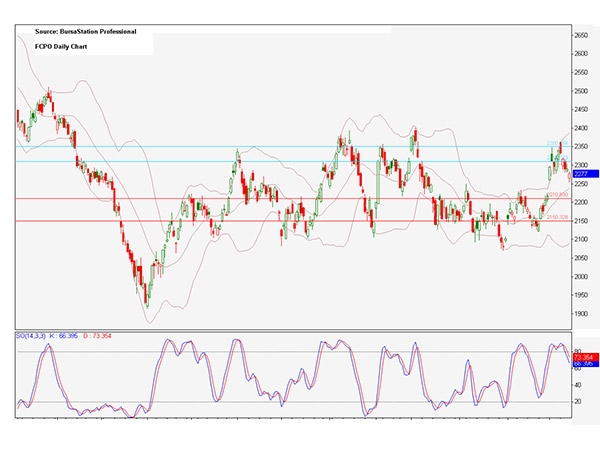 Malaysian palm oil futures edged lower on Friday to 2,277, due to oversupply concerns and a stronger ringgit which were compounded by signs that buyers could switch to competing oils.
Malaysian palm oil futures edged lower on Friday to 2,277, due to oversupply concerns and a stronger ringgit which were compounded by signs that buyers could switch to competing oils.
Future Crude Palm Oil (FCPO) benchmark August 2015 contract settled at 2,277 on Friday, down 63 points or 2.77 per cent from 2,340 last Friday.
Trading volume decreased to 140,130 contracts from 146,018 contracts from last Monday to Thursday.
Open interest based increased to 721,008 contracts from 672,192 contracts from last Monday to Thursday.
Cargo surveyor, Intertek Testing Services (ITS), reported that exports of Malaysia’s palm oil products during June 1 to 10 increased 2.2 per cent to 468,975 tonnes compared with 458,677 tonnes during May 1 to 10.
Another cargo surveyor, Societe Generale de Surveillance (SGS), reported that Malaysia’s palm oil exports during June 1 to 10 increased 1.9 per cent to 473,307 tonnes compared with 464,520 tonnes during May 1 to 10.
Overall, overseas demand weakened from China, India, and the EU, which could signal a slowdown from the robust buying seen last month. However, demand strengthened from the US and Pakistan.
Spot ringgit weakened on Friday to 3.758, after a German newspaper said the government officials are preparing for a Greek default, damping demand for emerging-market assets.
The Malaysian Palm Oil Board (MPOB) reported that Malaysian palm oil inventories increased 2.51 per cent in May from the previous month, as exports escalated, outpacing crude palm oil production, while overall inventories rose to 2.24 million tonnes from 2.19 million tonnes in May, the highest since November, while exports climbed 37.3 per cent to 1.61 million tonnes from 1.18 million tonnes.
Finally, MPOB stated that CPO output increased 6.92 per cent to 1.81 million tonnes from 1.69 million tonnes in May.
Malaysia plans to raise its biodiesel mandate to 10 per cent by October this year, from seven per cent currently. The B10 programme is expected to consume one million tonnes of crude palm oil a year, the minister said.
On Monday, the price fell, after touching the highest in three months, due to worries of weakening demand. However, the ringgit weakened to a nine year low, coupled with plans by Malaysia to increase its biodiesel mandate to 10 per cent by October, which supported the price.
On Tuesday, the price dropped, due to investors’ profit taking ahead of key industry data on monthly inventories and output, coupled with the ringgit clawing back gains from the previous day.
On Wednesday, the price continued to fall, staying within a tight range, after an industry report showed inventories in the world’s second-biggest producer swelled to a six-month high in May. Investors anticipate exports to bottom out ahead of the Ramadan period. Buyers typically replenish edible oil supplies ahead of the Muslim holy month of Ramadan in mid-June, marked by communal fasting and feasting that tends to drive up consumption.
On Thursday and Friday, the price fell, for the fifth consecutive day, heading for its biggest weekly loss since March, as the ringgit strengthened and concerns of oversupply in palm oil inventories, coupled with signs that buyers could switch to competing oils.
Technical analysis
According to the weekly FCPO chart, the price opened below top Bollinger band and closed above middle Bollinger band. The gains made during the previous week were eliminated this week as the price bounced to the top Bollinger band. However the price was unable to test either top or middle Bollinger band.
According to the daily FCPO chart, on Monday, the price opened above top Bollinger band, while forming an upside gap from 2,340 to 2,360, and could be covered in near term. By the later session, the upside gap was recovered, and the price closed below top Bollinger band, while the SO remained in overbought territory.
On Tuesday, the price opened below the psychological barrier at 2,300, while a downside gap was formed from 2,330 to 2,300. By the end of the day, the price closed above support line 2,310.
On Wednesday, the price opened above and tested the psychological level at 2,300. The price closed below the psychological barrier at 2,300. The downside gap formed during the previous day was unable to be covered.
On Thursday, the price opened below the support line at 2,310, while the SO exited overbought territory. By the later session, the price tested the psychological barrier at 2,300, closing below.
On Friday, the price opened below the psychological barrier at 2,300. A downside gap formed, from 2,290 to 2,265, which could be covered in near term, or signal continuation of downtrend into next week. By the later session, the price closed below the psychological barrier at 2,300.
In the coming week, the price has potential to range between 2,250 and 2,400. Resistance lines will be placed at 2,310 and 2,350, while support lines will be positioned at 2,210 and 2,150, these levels will be observed in the coming week.
Major fundamental news this coming week
ITS and SGS report released on the June 15 (Monday).
Oriental Pacific Futures (OPF) is a Trading Participant and Clearing Participant of Bursa Malaysia Derivatives. You may reach us at www.opf.com.my. Disclaimer: This article is written for general information only. The writers, publishers and OPF will not be held liable for any damage or trading losses that result from the use of this article.
